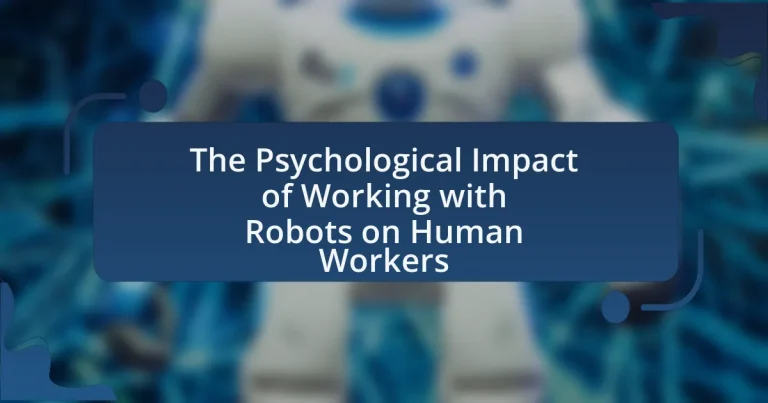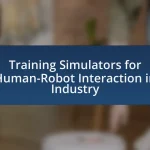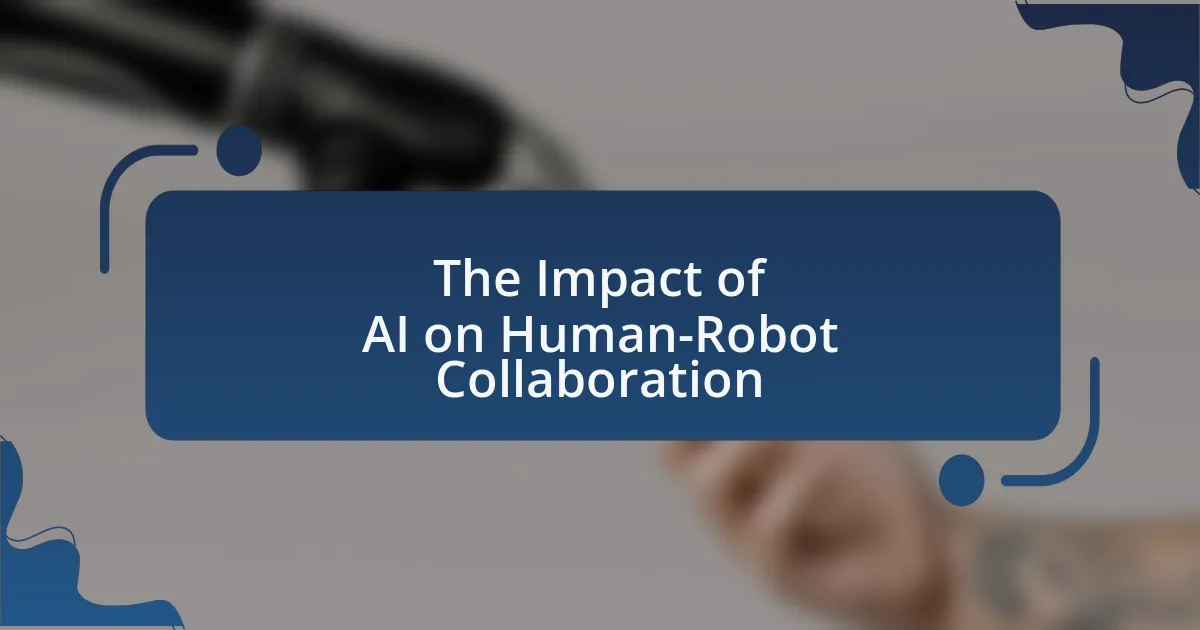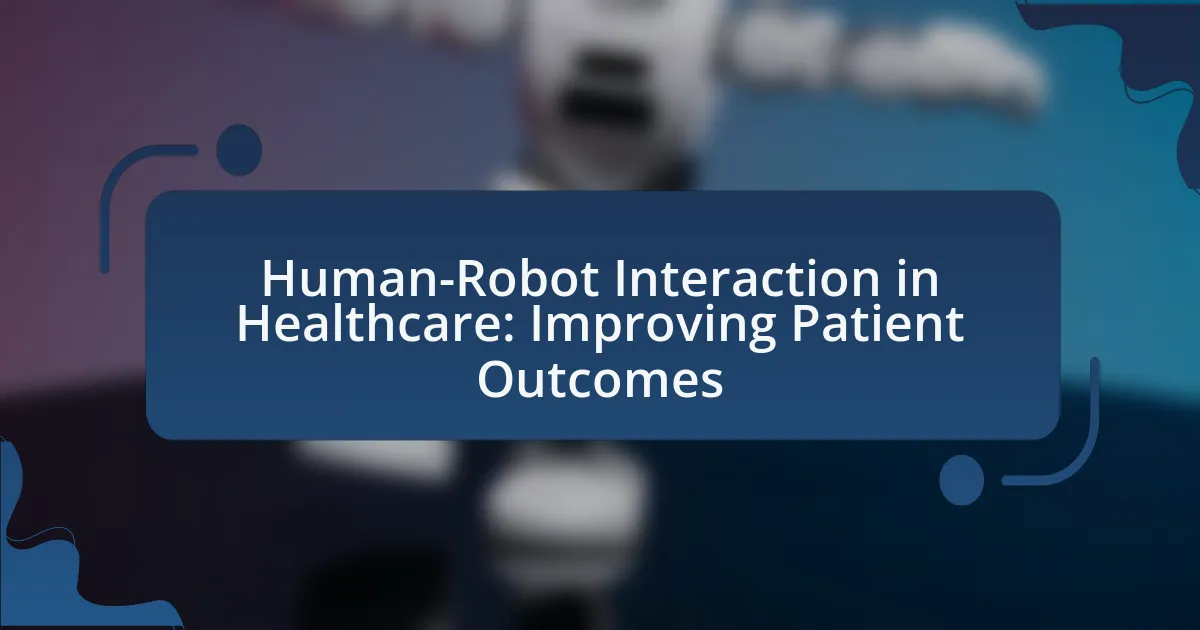The article examines the psychological impact of working with robots on human workers, highlighting issues such as increased anxiety, job insecurity, and changes in social dynamics. It discusses how the presence of robots can evoke a range of emotions, including trust and satisfaction, while also addressing the potential psychological benefits, such as reduced stress and enhanced creativity. The article further explores the challenges faced by workers, including communication barriers and fears of job displacement, and emphasizes the importance of effective training and workplace culture in mitigating negative psychological effects. Key strategies for improving worker morale and adapting to robotic collaboration are also outlined, providing insights into the evolving dynamics of human-robot interactions in the workplace.
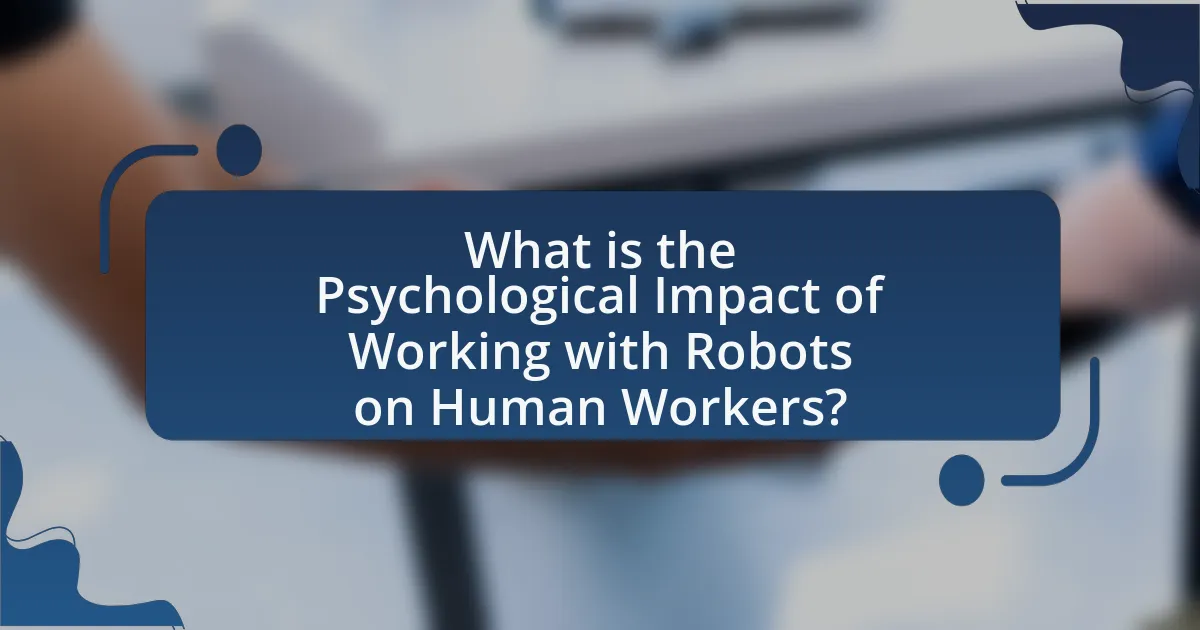
What is the Psychological Impact of Working with Robots on Human Workers?
The psychological impact of working with robots on human workers includes increased anxiety, job insecurity, and changes in social dynamics. Research indicates that human workers often experience stress due to fears of job displacement as automation rises; a study by the Pew Research Center found that 72% of workers are concerned about robots taking their jobs. Additionally, collaboration with robots can lead to altered interpersonal relationships, as workers may feel isolated or undervalued in environments where machines perform tasks traditionally done by humans. This shift can affect team cohesion and morale, further influencing overall job satisfaction and mental health.
How does the presence of robots in the workplace affect human emotions?
The presence of robots in the workplace significantly affects human emotions by influencing feelings of anxiety, job satisfaction, and social interaction. Research indicates that while some workers may experience anxiety due to fears of job displacement, others report increased job satisfaction as robots handle repetitive tasks, allowing humans to focus on more engaging work. A study published in the journal “Computers in Human Behavior” by authors H. H. Lee and J. H. Choi found that employees who collaborated with robots felt a sense of empowerment and improved morale, as they perceived robots as tools that enhance their capabilities rather than threats to their employment. Thus, the emotional impact of robots in the workplace is multifaceted, with both positive and negative effects depending on individual perceptions and the nature of the work environment.
What specific emotions are influenced by working alongside robots?
Working alongside robots influences specific emotions such as anxiety, trust, and satisfaction. Research indicates that the presence of robots can lead to increased anxiety among workers due to fears of job displacement and the unknown capabilities of robots. Conversely, trust can develop when workers perceive robots as reliable and beneficial to their tasks, enhancing collaboration. Additionally, job satisfaction may increase when robots assist in reducing workload and improving efficiency, as evidenced by studies showing that employees report higher satisfaction levels when robots handle repetitive tasks, allowing them to focus on more complex responsibilities.
How do these emotional changes manifest in daily work life?
Emotional changes manifest in daily work life through increased anxiety, altered job satisfaction, and shifts in interpersonal relationships among human workers. For instance, workers may experience anxiety due to fears of job displacement as robots take over tasks, leading to decreased job satisfaction and motivation. Research indicates that 60% of employees express concerns about automation affecting their roles, which can result in heightened stress levels and reduced productivity. Additionally, emotional changes can affect teamwork and collaboration, as workers may become more withdrawn or competitive, impacting overall workplace dynamics.
What are the potential psychological benefits of working with robots?
Working with robots can lead to several psychological benefits, including reduced stress, increased job satisfaction, and enhanced creativity. Research indicates that robots can take over repetitive and mundane tasks, allowing human workers to focus on more engaging and meaningful work, which can alleviate feelings of burnout and stress. A study published in the journal “Computers in Human Behavior” found that employees who collaborated with robots reported higher levels of job satisfaction due to the increased efficiency and support provided by robotic systems. Furthermore, the presence of robots can stimulate creativity by providing new tools and perspectives, encouraging workers to think innovatively.
How can robots enhance job satisfaction for human workers?
Robots can enhance job satisfaction for human workers by automating repetitive tasks, allowing employees to focus on more engaging and creative aspects of their jobs. This shift not only reduces monotony but also increases the sense of accomplishment and fulfillment among workers. Research indicates that when robots handle mundane tasks, employees report higher job satisfaction levels, as they can utilize their skills more effectively and experience greater autonomy in their roles. For instance, a study published in the Journal of Human-Robot Interaction found that workers who collaborated with robots on complex tasks experienced a 20% increase in job satisfaction compared to those performing solely manual tasks.
What role do robots play in reducing workplace stress?
Robots play a significant role in reducing workplace stress by automating repetitive tasks and enhancing efficiency. By taking over mundane and time-consuming activities, robots allow human workers to focus on more complex and fulfilling tasks, which can lead to increased job satisfaction. Research indicates that when employees are relieved from monotonous duties, they experience lower levels of stress and higher engagement in their work. For instance, a study published in the Journal of Occupational Health Psychology found that automation of routine tasks can lead to a 20% reduction in perceived stress among workers. This reduction in stress is attributed to the ability of robots to handle high-volume tasks, thereby minimizing workload and allowing for better work-life balance.
What challenges do human workers face when collaborating with robots?
Human workers face several challenges when collaborating with robots, primarily including communication barriers, job displacement fears, and trust issues. Communication barriers arise from differences in how humans and robots interpret tasks, leading to misunderstandings and inefficiencies. Job displacement fears are prevalent, as workers often worry that robots will replace them, which can lead to anxiety and decreased job satisfaction. Trust issues also emerge, as workers may be hesitant to rely on robots for critical tasks due to concerns about reliability and safety. These challenges can significantly impact the psychological well-being of human workers, affecting their performance and overall workplace dynamics.
How does job displacement anxiety affect workers’ mental health?
Job displacement anxiety significantly negatively impacts workers’ mental health by increasing stress, anxiety, and depression levels. Research indicates that individuals experiencing job displacement anxiety often report feelings of insecurity and fear about their future employment, which can lead to chronic stress responses. A study published in the Journal of Occupational Health Psychology found that workers facing potential job loss exhibited higher rates of anxiety and depressive symptoms, with 40% of participants indicating that job insecurity affected their overall well-being. This psychological strain can result in decreased job satisfaction and productivity, further exacerbating mental health issues.
What are the implications of reduced social interaction due to robots?
Reduced social interaction due to robots can lead to increased feelings of isolation and decreased emotional well-being among human workers. Research indicates that social interactions are crucial for mental health, and when robots replace human roles, the opportunities for meaningful connections diminish. A study published in the journal “Computers in Human Behavior” found that workers who engaged less with colleagues reported higher levels of stress and lower job satisfaction. Furthermore, the lack of social engagement can impair teamwork and collaboration, essential components for a productive work environment. This shift can also lead to a decline in communication skills over time, as individuals become less accustomed to interpersonal interactions.

How do different types of robots influence human psychology?
Different types of robots influence human psychology by shaping emotional responses, altering social interactions, and affecting job satisfaction. For instance, social robots, like companion robots, can evoke feelings of comfort and companionship, leading to reduced loneliness and improved mental health among users. In contrast, industrial robots may create anxiety or stress in workers due to fears of job displacement, as evidenced by studies showing that automation can lead to increased job insecurity and decreased morale among employees. Additionally, the presence of robots in the workplace can foster a sense of collaboration or competition, depending on the nature of the tasks they perform and the human-robot interaction dynamics. Research indicates that positive interactions with robots can enhance motivation and productivity, while negative experiences can lead to resistance and disengagement.
What are the psychological effects of collaborative robots (cobots) on workers?
Collaborative robots (cobots) can significantly influence the psychological well-being of workers, often leading to increased job satisfaction and reduced stress levels. Research indicates that when workers interact with cobots, they experience a sense of enhanced productivity and safety, as these robots are designed to assist rather than replace human labor. A study published in the journal “Human Factors” by authors K. H. Lee and J. H. Kim found that workers reported lower anxiety levels and greater confidence in their tasks when collaborating with cobots, attributing this to the robots’ ability to handle repetitive or hazardous tasks. Furthermore, the presence of cobots can foster a more engaging work environment, promoting teamwork and communication among employees.
How do cobots change the dynamics of teamwork?
Cobots, or collaborative robots, significantly alter the dynamics of teamwork by enhancing collaboration between human workers and machines. These robots are designed to work alongside humans, allowing for a more integrated approach to tasks that require both human intuition and robotic precision. Research indicates that the presence of cobots can lead to improved efficiency and productivity, as they take over repetitive or hazardous tasks, enabling human workers to focus on more complex and creative aspects of their jobs.
For instance, a study published in the journal “Human Factors” found that teams utilizing cobots reported a 30% increase in task completion rates compared to teams without robotic assistance. This shift not only optimizes workflow but also fosters a sense of partnership, as human workers often feel empowered by the support of cobots, leading to increased job satisfaction and reduced stress levels. Thus, cobots fundamentally reshape teamwork dynamics by promoting collaboration, enhancing productivity, and improving worker morale.
What are the perceptions of safety when working with cobots?
Perceptions of safety when working with cobots are generally positive, as many workers feel that collaborative robots enhance workplace safety by reducing the risk of injury during repetitive tasks. Research indicates that cobots are designed with safety features such as force limiters and sensors that prevent collisions, which contributes to a safer working environment. A study published in the journal “Robotics and Autonomous Systems” by authors K. H. Lee and J. H. Kim found that 78% of participants reported increased feelings of safety when working alongside cobots compared to traditional industrial robots. This perception is further supported by the fact that cobots can take over hazardous tasks, allowing human workers to focus on more complex and less dangerous activities.
How do autonomous robots impact human workers’ mental states?
Autonomous robots can significantly impact human workers’ mental states by inducing feelings of anxiety and job insecurity. Research indicates that the presence of robots in the workplace can lead to concerns about job displacement, which heightens stress levels among employees. A study published in the journal “Computers in Human Behavior” by authors such as H. H. Lee and J. H. Kim found that workers often experience increased anxiety when they perceive robots as competitors rather than collaborators. This perception can diminish job satisfaction and overall mental well-being, as employees may feel threatened by the capabilities of autonomous systems.
What fears arise from the use of autonomous robots in the workplace?
Fears arising from the use of autonomous robots in the workplace include job displacement, loss of control, and safety concerns. Job displacement is a significant fear, as studies indicate that automation could replace up to 25% of jobs in certain sectors by 2030, leading to economic insecurity for workers. Loss of control manifests when employees feel that robots may make decisions without human oversight, potentially leading to ethical dilemmas. Safety concerns are also prevalent, with reports showing that accidents involving robots can result in serious injuries, raising anxiety about workplace safety. These fears collectively impact employee morale and trust in the workplace environment.
How do workers perceive their roles in relation to autonomous robots?
Workers generally perceive their roles in relation to autonomous robots as complementary rather than competitive. Many employees recognize that autonomous robots can enhance productivity and efficiency, allowing them to focus on more complex tasks that require human judgment and creativity. Research indicates that 70% of workers believe that robots will take over repetitive tasks, enabling them to engage in higher-value work (Source: Pew Research Center, 2021). This perception fosters a collaborative mindset, where workers view robots as tools that augment their capabilities rather than threats to their job security.
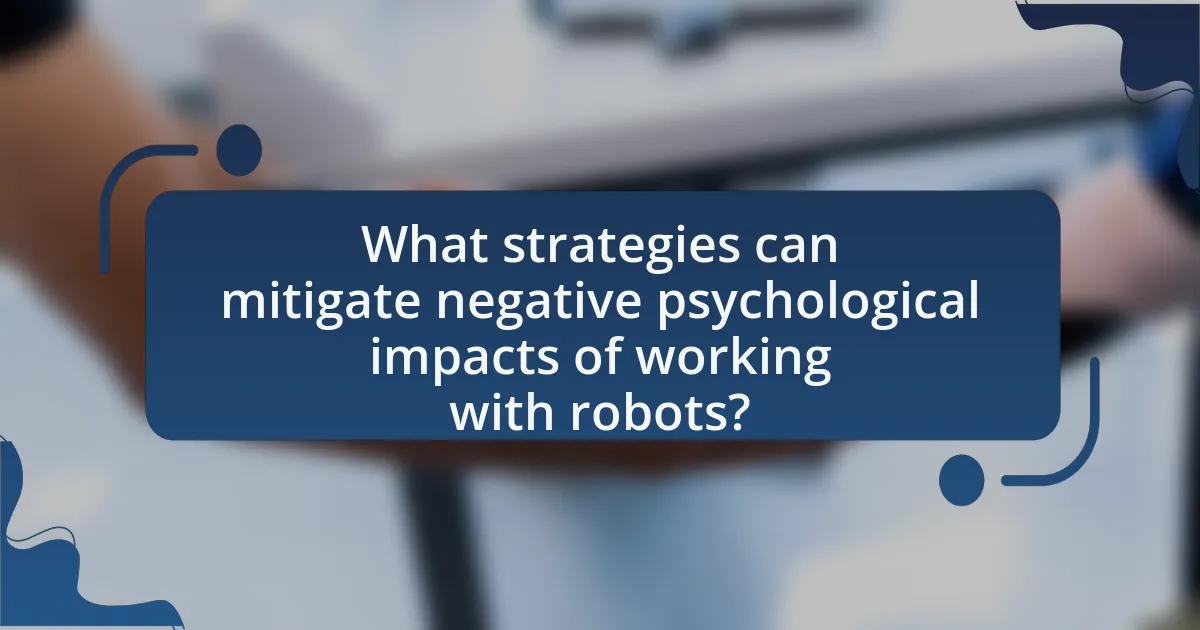
What strategies can mitigate negative psychological impacts of working with robots?
To mitigate negative psychological impacts of working with robots, organizations can implement strategies such as providing comprehensive training, fostering a collaborative work environment, and ensuring open communication. Comprehensive training equips employees with the necessary skills to work alongside robots, reducing anxiety and increasing confidence. A collaborative work environment encourages teamwork between human workers and robots, promoting a sense of belonging and reducing feelings of isolation. Open communication allows employees to express concerns and share experiences, which can alleviate stress and improve mental well-being. Research indicates that these strategies can enhance job satisfaction and reduce anxiety related to automation, as highlighted in studies by the International Journal of Human-Computer Interaction.
How can organizations support workers in adapting to robotic coworkers?
Organizations can support workers in adapting to robotic coworkers by providing comprehensive training programs that focus on collaboration with robots. These training initiatives can enhance workers’ understanding of robotic functionalities and improve their comfort level in interacting with these technologies. Research indicates that effective training can reduce anxiety and increase job satisfaction, as seen in a study by the Massachusetts Institute of Technology, which found that employees who received training on robotic systems reported a 30% increase in confidence when working alongside robots. Additionally, organizations can foster a culture of open communication, allowing workers to express concerns and share experiences related to robotic integration, which can further alleviate psychological stress.
What training programs are effective in easing the transition to robot-assisted work?
Effective training programs for easing the transition to robot-assisted work include hands-on technical training, collaborative robotics workshops, and soft skills development courses. Hands-on technical training equips workers with the necessary skills to operate and troubleshoot robotic systems, which is essential for building confidence and competence. Collaborative robotics workshops focus on teamwork and communication strategies when working alongside robots, fostering a positive work environment. Soft skills development courses enhance adaptability and problem-solving abilities, which are crucial as job roles evolve with automation. Research indicates that organizations implementing these training programs report higher employee satisfaction and reduced anxiety related to robot integration, demonstrating their effectiveness in facilitating a smoother transition.
How can communication strategies improve worker-robot relationships?
Communication strategies can enhance worker-robot relationships by fostering clarity, trust, and collaboration. Effective communication reduces misunderstandings and increases the predictability of robot actions, which can alleviate anxiety among human workers. For instance, studies have shown that when robots provide clear feedback and status updates, workers feel more in control and confident in their interactions, leading to improved job satisfaction and productivity. Research published in the journal “Human Factors” indicates that transparent communication from robots can significantly enhance user acceptance and reduce perceived risks associated with automation.
What best practices can enhance the psychological well-being of human workers?
Best practices that can enhance the psychological well-being of human workers include promoting a supportive work environment, encouraging open communication, and providing opportunities for professional development. A supportive work environment fosters trust and collaboration, which has been shown to reduce stress and increase job satisfaction. Open communication allows workers to express concerns and share feedback, leading to a more engaged workforce. Additionally, opportunities for professional development can enhance workers’ skills and career prospects, contributing to a sense of purpose and fulfillment. Research indicates that organizations prioritizing these practices experience lower turnover rates and higher employee morale, demonstrating their effectiveness in improving psychological well-being.
How can regular feedback mechanisms improve worker morale in robotic environments?
Regular feedback mechanisms can significantly improve worker morale in robotic environments by fostering a sense of engagement and recognition among employees. When workers receive consistent feedback, they feel valued and understood, which enhances their emotional connection to their tasks and the organization. Research indicates that employees who receive regular feedback report higher job satisfaction and motivation levels, as it helps them understand their performance and areas for improvement. For instance, a study published in the Journal of Applied Psychology found that feedback positively correlates with employee engagement, leading to increased productivity and morale. This connection between feedback and morale is particularly crucial in robotic environments, where human workers may feel isolated or undervalued due to the presence of automation.
What role does workplace culture play in integrating robots successfully?
Workplace culture plays a crucial role in the successful integration of robots by shaping employee attitudes and acceptance towards automation. A positive workplace culture that emphasizes collaboration, innovation, and adaptability fosters an environment where employees are more likely to embrace robotic technologies. Research indicates that organizations with strong, supportive cultures experience higher employee engagement and lower resistance to change, which is essential when introducing robots into workflows. For instance, a study by the MIT Sloan School of Management found that companies with a culture of trust and open communication saw a 30% increase in employee acceptance of new technologies, including robotics. This demonstrates that a conducive workplace culture not only facilitates smoother transitions but also enhances overall productivity and morale among human workers interacting with robots.
What are the key takeaways for workers adapting to robotic collaboration?
Workers adapting to robotic collaboration should focus on developing complementary skills that enhance their ability to work alongside robots. This includes improving technical proficiency to understand robotic systems, fostering communication skills to effectively interact with robotic counterparts, and embracing a mindset of continuous learning to keep pace with technological advancements. Research indicates that workers who engage in training programs that emphasize these areas experience increased job satisfaction and reduced anxiety related to automation, as highlighted in a study by the International Federation of Robotics, which found that 70% of workers felt more confident in their roles after receiving training on robotic systems.
